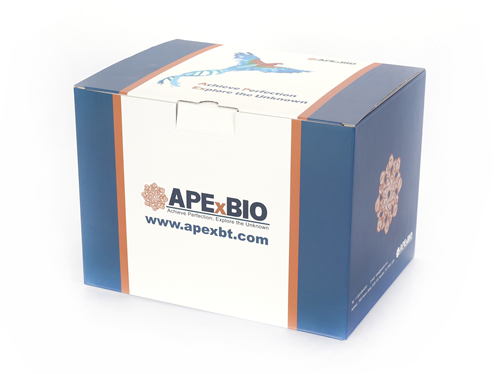- Home
- Signaling Pathways
- GPCR/G protein
- Prostanoid Receptors
- Prostaglandin E2
Prostaglandin E2
Ki = 9.1, 4.9, 0.33, 0.79 nM for EP1, EP2, EP3, and EP4 receptors respectively [1]
Prostaglandin E2 (PGE2) is lipid-derived autacoid which is the main effector prostanoid produced in the zebrafish, and it works by binding and activating the PGE2 receptor. PGE2 receptor is a orphan G protein-coupled receptor.
In vitro: PGE2 can stimulate the gastric nonparietal secretion [3] and has been shown to regulate the function of many cell types including dendritic cells, macrophages, T and B lymphocytes leading to both pro- and anti-inflammatory effects [2].
In vivo: PGE2 regulates many physiological systems including the gastrointestinal and immune systems. In the gastrointestinal tract, PGE2 plays a protective role in maintaining the integrity of the gastric mucosa. PGE2 has also been shown to play a role in the maintenance of blood pressure, particularly in the setting of salt overload [2].
Clinical trial: PGE2 has cytoprotective properties, which prevents mucosal damage of the gastrointestinal tract and also accelerates the healing of existent duodenal ulcers [3]. PGE2 is the active ingredient of dinoprostone, which is a medicine used in labour for softening the cervix and causing uterine contraction.
References:
[1] Abramovitz M1, Adam M, Boie Y, Carrière M, Denis D, Godbout C, Lamontagne S, Rochette C, Sawyer N, Tremblay NM, Belley M, Gallant M, Dufresne C, Gareau Y, Ruel R, Juteau H, Labelle M, Ouimet N, Metters KM. The utilization of recombinant prostanoid receptors to determine the affinities and selectivities of prostaglandins and related analogs. Biochim Biophys Acta. 2000 Jan 17;1483(2):285-93.
[2] Hata AN, Breyer RM. Pharmacology and signaling of prostaglandin receptors: multiple roles in inflammation and immune modulation. Pharmacol Ther. 2004 Aug;103(2):147-66.
[3] Johansson C, Kollberg B. Clinical trials with prostaglandin E2. Prostaglandins. 1981;21 Suppl:161-4.
| Physical Appearance | A crystalline solid |
| Storage | Store at -20°C |
| M.Wt | 352.47 |
| Cas No. | 363-24-6 |
| Formula | C20H32O5 |
| Solubility | ≥35.2 mg/mL in EtOH; insoluble in H2O; ≥42.8 mg/mL in DMSO |
| Chemical Name | (Z)-7-((1R,2R,3R)-3-hydroxy-2-((S,E)-3-hydroxyoct-1-en-1-yl)-5-oxocyclopentyl)hept-5-enoic acid |
| SDF | Download SDF |
| Canonical SMILES | O[C@H](C1)[C@H](/C=C/[C@H](CCCCC)O)[C@@H](C/C=C\CCCC(O)=O)C1=O |
| Shipping Condition | Small Molecules with Blue Ice, Modified Nucleotides with Dry Ice. |
| General tips | We do not recommend long-term storage for the solution, please use it up soon. |
| Cell experiment [1]: | |
|
Cell lines |
HEK293 cells |
|
Preparation method |
The solubility of this compound in DMSO is > 10 mM. General tips for obtaining a higher concentration: Please warm the tube at 37℃ for 10 minutes and/or shake it in the ultrasonic bath for a while. Stock solution can be stored below -20℃ for several months. |
|
Reacting condition |
N/A |
|
Applications |
In HEK293 cells, prostaglandin E2 bound the FP receptor with Ki value of 119 nM. PGE2 production in the kidney is critical for normal renal function by preserving renal blood flow and glomerular filtration rate in settings of physiological stress, modulating salt and water transport in the distal tubule, and stimulating renin release from the juxtaglomerular apparatus. |
| Clinical Trial [2]: | |
|
Disease models |
patients with rheumatic diseases |
|
Dosage form |
oral 1 mg three times daily or 0.33 mg three times daily |
|
Application |
In patients with rheumatic diseases, the indomethacin-induced bleeding was reduced to control level by concomitant oral PGE2 1 mg three times daily and was significantly reduced by 0.33 mg three times daily. |
|
Other notes |
Please test the solubility of all compounds indoor, and the actual solubility may slightly differ with the theoretical value. This is caused by an experimental system error and it is normal. |
|
References: [1] Hata AN, Breyer RM. Pharmacology and signaling of prostaglandin receptors: multiple roles in inflammation and immune modulation. Pharmacol Ther. 2004 Aug;103(2):147-66. [2] Johansson C, Kollberg B. Clinical trials with prostaglandin E2. Prostaglandins. 1981;21 Suppl:161-4. |
|
Quality Control & MSDS
- View current batch:
Chemical structure








